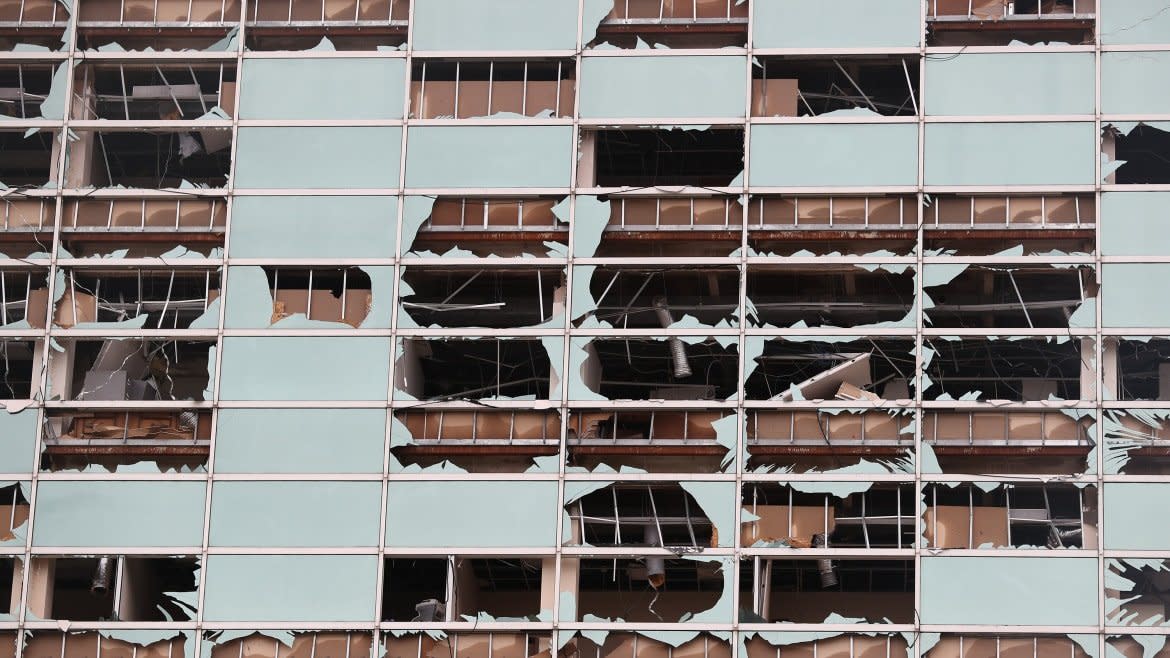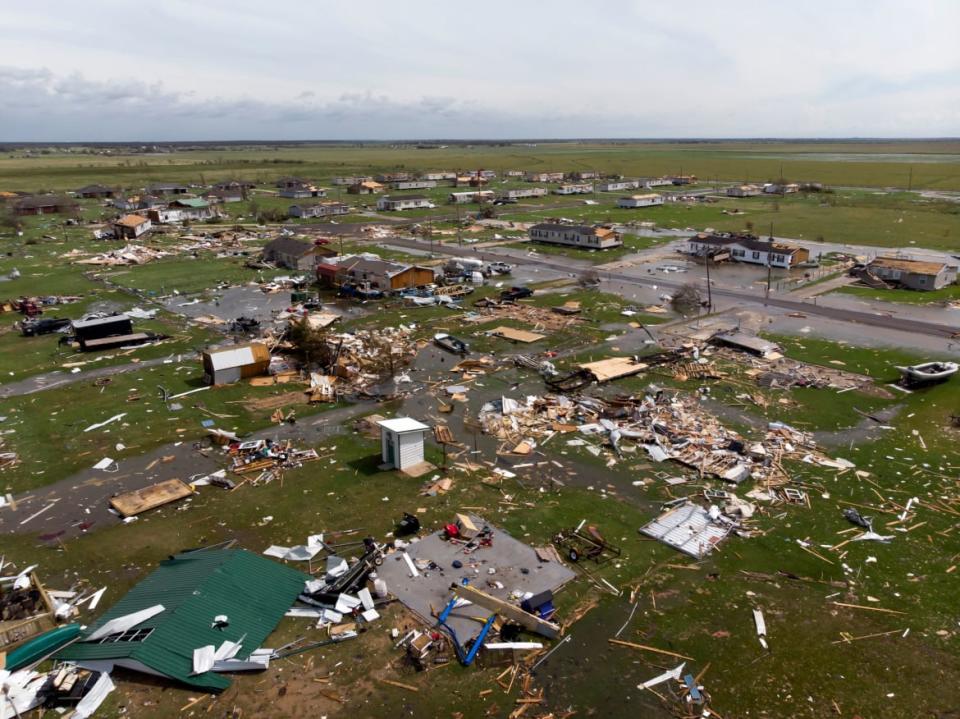‘Like an Alien Ship Came Down’: Residents Confront Hurricane Laura’s Wrath

LAFAYETTE, Louisiana—Dawn over the Gulf Coast revealed initial damage from Hurricane Laura, which hammered the region hours after making landfall overnight in the tiny parish seat of Cameron as a Category 4 storm.
Winds of up to 150 mph put it among the most powerful storms yet to hit the U.S. Officials initially feared an “unsurvivable” storm surge that was forecast to push a wall of water an unthinkable 40 miles inland. Laura was later downgraded to a tropical storm.
Louisiana officials announced six deaths linked to Laura, including a 14-year-old girl killed when a tree fell on her home, a 24-year-old man who died of carbon monoxide poisoning from a generator in his home, a man who drowned aboard a sinking ship, and two others who died from falling tress. Texas Gov. Greg Abbott said he’d received unconfirmed reports of one death near Sabine County.
“We do expect that there could be more fatalities,” Christina Stephens, a spokesperson for Edwards, told reporters.

The hurricane tore through Lake Charles, Louisiana.
Images from the city of Lake Charles showed entire skyscrapers with their windows blown out as winds well over 100 mph whipped the city beloved as a travel destination. Police reportedly spotted a casino that floated away. The National Weather Service issued several warnings for tornadoes in the area, but none have been confirmed to have touched down.
In Delcambre, near the coast south of Lafayette, Jacob Lombas said Thursday morning that his own house was just inches away from flooding and his neighbors’ had already done so.
“It was a crazy night. I barely got any sleep. The wind was the worst I’ve ever seen,” he told The Daily Beast, adding, “We had to go next door to my dad’s. His house is raised up.”
Breaking news major damage in Downtown Lake Charles many skyscrapers have blown out winds.
Some of the building may be total losses.
Many roof off massive flying debris. @NWSLakeCharles #lawx #HurricaneLaura pic.twitter.com/s9EgeDtz43— Jeff Piotrowski (@Jeff_Piotrowski) August 27, 2020
At least 800,000 homes and businesses were without power, according to the website PowerOutage.Us.
NOLA.com reported the highest wind gusts were recorded at the Lake Charles airport, 132 mph, and at the Emergency Operations Center in downtown Lake Charles, according to Joshua Schroeder, a National Weather Service meteorologist in Brownsville, Texas. The outlet reported the Brownsville office was backing up its Lake Charles counterpart, which was forced to evacuate.
Schroeder told NOLA.com the NWS had lost contact with radars at Lake Charles and Fort Polk overnight, likely due to “equipment issues” in the raging storm.
Storm chasers on social media posted videos of heavy rain and swirling winds, which meteorologist Reed Timmer reported was “gutting buildings” around Lake Charles as the eye wall of Laura moved through.
BREAkING! Buildings gutted in Lake Charles LA in powerful eye wall of #HurricaneLaura @RadarOmega_WX @ChasinSpin pic.twitter.com/wP3fPyREIZ
— Reed Timmer (@ReedTimmerAccu) August 27, 2020
As of Thursday morning, more than 500,000 people had lost power in Louisiana and Texas, with many more outages expected.
“Unsurvivable storm surge with large and destructive waves will cause catastrophic damage from Sea Rim State Park, Texas, to Intracoastal City, Louisiana, including Calcasieu and Sabine Lakes,” the National Hurricane Center said ahead of the storm’s arrival. “This surge could penetrate up to 30 miles inland from the immediate coastline.” Later advisories pushed that threat to 40 miles inland.
Even after nightfall, we have the tools to keep watch, and issue the life saving warnings to keep you, your family and friends safe. We're going to be watching #Laura all night, thinking of those of you facing the brunt of the storm.https://t.co/VyWINDk3xP for the latest. pic.twitter.com/heSYqX0kyQ
— National Weather Service (@NWS) August 27, 2020
Edward Rappaport, deputy director of the National Hurricane Center, told The Daily Beast exactly what the term “unsurvivable” means.
“At its worst, the storm surge will reach from 15 to 20 feet, with waves riding on top of that,” he said. “I cannot imagine what that means to any human who is in the line of that water. Any human or structure.”
Footage from the National Oceanic and Atmospheric Administration’s Aircraft Operations Center showed its Hurricane Hunter pilots struggling in heavy turbulence squarely in the eye of the hurricane.
OVER THE GULF OF MEXICO - Aug. 26, 2020. Heavy turbulence leaving the eye of Category 4 Hurricane #Laura on @NOAA WP-3D Orion #NOAA42 Kermit. Credit: Lt. Cmdr. Doremus, NOAA Corps. Our thoughts are with all in this storm's path. #FlyNOAA pic.twitter.com/m7Bc3Gttnn
— NOAA Aircraft Operations Center (@NOAA_HurrHunter) August 27, 2020
Officials in Texas and Louisiana ordered more than 580,000 people to evacuate, including those in areas severely damaged during Hurricane Harvey in 2017. At least 6 million people in Louisiana and Arkansas were also under a flash flood watch. Arkansas has also declared a state of emergency in preparation for the storm, setting aside $250,000 for relief efforts.
As many departed, an ominous signal of the storm’s strength appeared on the Mississippi River, which was forced to flow backward as Laura approached, an anomaly seen only during the strongest of hurricanes that have raked the Delta.
The Texas Hurricane Center on Wednesday issued evacuation warnings to more than 385,000 residents from several areas, including Beaumont, Galveston, and Port Arthur. Ten more Texas cities and counties issued voluntary evacuation orders, including parts of Houston, as officials stressed residents should remain vigilant and prepared. All told, about 60 Texas counties were under a disaster declaration.
“If you decide to stay, you are on your own,” Port Arthur, Texas, Mayor Thurman Bartie said at a press conference. “I will not put my people in harm’s way. If you stay, it is you and God.”
Only a couple of hours remain to protect life and property! Unsurvivable storm surge with large and destructive waves will cause catastrophic damage from Sea Rim State Park, Texas, to Intracoastal City, Louisiana, including Calcasieu and Sabine Lakes #lawx #txwx #HurricaneLaura pic.twitter.com/eYTEH89rGu
— NWS Lake Charles (@NWSLakeCharles) August 26, 2020
In Louisiana, about 200,000 people were ordered to leave Calcasieu Parish and parts of Cameron Parish—low-lying coastal regions that were already seeing flooding hours before the storm was set to make landfall. Social media posts on Wednesday showed rising waters along southeast Louisiana and even parts of coastal Alabama. The City of New Orleans Emergency Medical Services on Wednesday said they were sending their ambulance bus to southwest Louisiana to further aid evacuation efforts.
Here’s the current state of LA 1 below the Leon Theriot Lock in Golden Meadow. The highway remains closed and this area remains under a mandatory evacuation. #Laura pic.twitter.com/p5OkD7t0wN
— Lafourche Parish Sheriff’s Office (@LafourcheSO) August 26, 2020
Among the evacuees was Fabienne Celestin, who found herself stuck in Lake Charles without enough money to get out of town, and had never been in an emergency evacuation situation, especially not while facing a monster like Laura. A Florida native, she moved to Lake Charles in late 2010. So she missed the devastation of Katrina and Rita in 2005 and the double whammy of Gustav and Ike in 2008.
And she was desperate to get out of town with her children—Roodson, 16, Jayden, 10, and Moisha, 4—before Laura came ashore.
“I didn’t have no gas money, no transportation,” she told The Daily Beast Wednesday night. “I have one special-needs child. He was crying. I have no help, but at the last minute a friend sent me some gas money so I was able to make it to Lafayette.”
The desperation of being trapped made Celestin frantic. To top things off, her boyfriend was arguing with her about the decision to evacuate, she recalled: “I was scared because I never took the highway before.”
Even with her own emotions on edge, she had to keep things together—especially for Roodson.
“It is a scary situation,” Celestin said. “My special-needs son didn't understand, so he was asking a lot of questions.”
Emergency workers had already been in Lake Charles for 48 hours, helping people in need like Celestin find shelter out of the storm’s path. When storms approach, the state’s Department of Children and Family Services coordinates transportation for thousands of evacuees.
Gov. Bel Edwards said in a news conference Wednesday that Hurricane Laura had the potential to bring storm surges that residents had not seen seen since 1957. He added that Louisiana had activated its entire National Guard, something it hasn’t done in “many years.”
“This is a very serious storm,” he said. “In the five years I’ve been governor, I don’t believe I’ve had a press conference where it was my intention to convey the sense of urgency that I am trying to convey right now.”
The storm coincided with the Republican National Convention, where the danger it posed received little attention. CBS reported that President Donald Trump had been briefed only once on the impending storm as of Wednesday afternoon. He tweeted Wednesday, “Hurricane Laura is a very dangerous and rapidly intensifying hurricane. My Administration remains fully engaged with state & local emergency managers to continue preparing and assisting the great people Texas, Louisiana, and Arkansas. Listen to local officials. Listen to local officials!”
Bonnie Lee, a Lake Charles resident for 40 years, saw her home ravaged by the storm while her neighbors were pretty much untouched, she explained in an interview on Thursday. Among other damage, she said the chimney had been completely taken off, roof shingles were gone, and that there was “a hole in the roof like an alien ship came down and put in a new skylight.”
Bizarrely, she explained, her potted plants were fine: “Apparently an asparagus fern can survive a hurricane. It’s unscathed.”
It was a marked contrast with some of the more notorious storms to roll through the area in previous years.
“During Hurricane Rita, we had no damage at all,” Lee told The Daily Beast. “This one got us.”
Got a tip? Send it to The Daily Beast here
Get our top stories in your inbox every day. Sign up now!
Daily Beast Membership: Beast Inside goes deeper on the stories that matter to you. Learn more.

